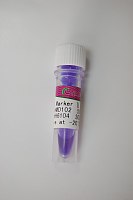Gene Correction Frequency by Chimeric RNA-DNA Oligonucleotide Using Nuclear Extracts
互联网
496
Site-specific correction of single-base mutations in target DNA sequences has been developed using an RNA-DNA hybrid oligonucleotide (RDO) to correct or cause a specific point mutation in episomal and genomic DNA (1 –14 ). In its original design, an RDO was composed of two strands, one strand containing both RNA and DNA (RNA-containing strand) and the other strand fully complementary to the RNA-containing strand but consisting of all DNA (DNAcontaining strand; Fig.1 ). The RNA was incorporated because an RNA-DNA hybrid duplex is more active than a DNA duplex in homologous recombination by the RecA and Rec2 proteins (15 ,16 ). To render the oligonucleotide resistant to the RNaseH, ribose sugars were 2′-O -methylated, and to protect the 5′ and 3′ ends, a five GC clamp was placed at each end of the molecule. This original RDO molecule was empirically designed and has been modified subsequently. Recent RDO designs include a complete sequence complementarity of the RNA-containing strand to target DNA, a replacement of the central five DNA residues with 2′-O -methyl RNA, a placement of mismatch in the DNA-containing strand, and a chemical modification of the hairpin loops. These modifications result in a 3- to 10-fold increase in gene correction activity (17 ,18 ). These results suggest that two different functions could be imparted to two strands of RDO: the RNA-containing strand stabilization of a labile intermediate and the DNA-containing strand for strand pairing and directing DNA repair activity.


Fig. 1. The structure of RDO. RDO consists of RNA- and DNA-containing strands linked by a double T-loop and a 5-bp GC clamp. The RNA-containing strand has 10 2′-O -methyl RNA residues (R) flanking either side of a 5-residue DNA (D) stretch, which contains the base change desired for the mutation. The sequence of the RNAcontaining strand is complementary to the targeted DNA over a stretch of 25 residues except for a single mismatch (A:C) to the targeted base to be altered. The DNA-containing strand is complementary to the RNA-containing strand.









